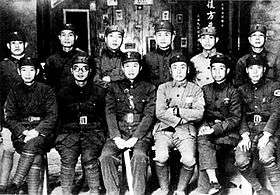New Fourth Army
| New Fourth Army | |
|---|---|
| Active | 12 October 1937 - 23 January 1947 |
| Country |
|
| Allegiance |
|
| Branch |
|
| Type | Army Light Infantry |
| Role | Guerrilla Warfare |
| Size |
10,300+ (1937) 290,000+ (1947) |
| Part of |
CPC Central Military Commission Nationalist Government Military Affairs Commission |
| Garrison/HQ | Jiangsu, Anhui |
| Motto(s) | Resolving the National Crisis (共赴国难) |
| Colors | Grey Uniform |
| Equipment | Hanyang 88, Chiang Kai-shek rifle, Type 38 rifle, Mauser C96, Type 41 75 mm Mountain Gun |
| Engagements | Second Sino-Japanese War, Chinese Civil War |
| Commanders | |
| Notable commanders | Ye Ting, Ding Ying, Liu Shaoqi, Chen Yi, Su Yu |

The New Fourth Army (simplified Chinese: 新四军; traditional Chinese: 新四軍; pinyin: Xīn Sì Jūn) was a unit of the National Revolutionary Army of the Republic of China established in 1937. In contrast to most of the National Revolutionary Army, it was controlled by the Communist Party of China and not by the ruling Kuomintang. The New Fourth Army and the Eighth Route Army were the two main communist forces from 1938. The New Fourth Army was active south of the Yangtze River (Chang Jiang), while the Eighth Route Army was based in Yan'an in the northwest.
Members of the New Fourth Army wore their badges on the left arm, with "N4A" and the soldier's unit and name listed on the badge.
After the Xi'an Incident, the Kuomintang led by Chiang Kai-shek and the Communist Party of China led by Mao Zedong formed a United Front against Japan, which was already in control of Manchuria and pushing into North China. The Marco Polo Bridge Incident in July 1937 marked the beginning of the Sino-Japanese War (1937-1945).
In October, 1937, an announcement was made that Red Army soldiers active in the eight provinces in southern China — those who did not embark on the Long March would be part of the New Fourth Army. The New Fourth Army was established on December 25, 1937 in Hankou, moving to Nanchang on January 6, 1938, when the detachments began marching to the battlefront. At the beginning, the New Fourth Army had four detachments and one task force battalion and numbered roughly ten thousand. Later the army moved to Anhui province. Ye Ting was the army commander, Xiang Ying the deputy army commander.
It was in theory a united front against Japan but in practice there was friction between Nationalist and Communist Forces, which intensified in the fall of 1940, culminating in the New Fourth Army Incident with a full-fledged battle between the New Fourth Army and KMT National Revolutionary Army forces. Up until that point, most of the battles had been skirmishes. The army was fully reorganised after the incident and remained in active combat until the end of the war.
| Wikimedia Commons has media related to 中國工農紅軍. |